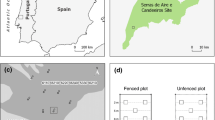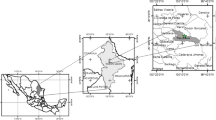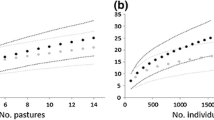Abstract
This paper deals with effects of sheep and goat grazing on plant species diversity, species richness and species composition in two important conservation areas of the Western Himalaya; the Valley of Flowers (VOF) National Park and the Great Himalayan National Park (GHNP). The VOF is a completely Protected Area as it is devoid of livestock grazing whereas, 20,000 sheep and goats annually graze in GHNP. Both the National Parks possess sub-alpine and alpine vegetation that is distributed in 13 major habitat types. Present investigations indicate that all the habitat types in VOF are higher in plant species diversity and richness compared to habitat types in GHNP. Similarly, all three eco-climatic zones in VOF are higher in species diversity and richness compared to GHNP. Species diversity also decreases with increasing altitude in both the National Parks. The findings of this study are discussed in the light of the management and conservation of alpine meadows of the Western Himalayas.
Similar content being viewed by others
References
Anon (1972) Wildlife (Protection) Act. Goverment of India, New Delhi: Ministry of Environment and Forest.
Atkinson, E.T. (1882) Gazetteer of Himalayan District of North-West Provinces and Oudh. Dehra Dun: Natraj Publishers.
Billings, W.D.(1973) Arctic and alpine vegetation: similarities, differences and susceptibility to disturbance. Bioscience 23, 697–704.
Dirzo, R.(1984) A phytocentric overview. In Perspectives in Plant Population Biology (R. Dirzo and J. Sarukhan, eds.) pp. 141–65. Sunderland, MA: Sinauer Associated.
Harper, J.L. (1969) The role of predation in vegetational diversity. Brookhaven Symposium inBiology 22, 48–62.
Hik, D.S., Jefferies, R.L. and Sinclair, A.R.E. (1992) Foraging by geese, isostatic upleft and asymmetry in thedevelopment of salt marsh plant communities. J. Ecology 80, 395–406.
Kala, C.P. (1998a) Ecology and Conservation of AlpineMeadows in the Valley of Flowers National Park, Garhwal Himalaya. Ph.D. Thesis, Forest Research Institute, Dehra Dun, India, 180 pp.
Kala, C.P. (1998b) Ethnobotanical Survey and Propagation of Rare Medicinal Herbs for Small Farmers in the Buffer Zone of the Valley of FlowersNational Park, Garhwal Himalaya. A Report, ICIMOD, Nepal, 35 pp.
Kala, C.P. and Rawat, G.S. (1999) Effects of livestock grazing onthe species diversity and biomass production in the alpine meadows of Garhwal Himalaya, India. Tropical Ecology 40, 69–74.
Kala, C.P., Rawat, G.S. and Uniyal, V.K. (1998) Ecology and Conservation of the Valley of Flowers National Park, Garhwal Himalaya.Wildlife Institute of India, Dehra Dun, India, 99 pp.
Kala, C.P., Uniyal, V.K. and Rawat, G.S. (1995) An interim report on the Valley ofFlowers National Park, Montane Grassland Project. Wildlife Institute of India, Dehra Dun, India, 52 pp.
Kumar, K.and Joshi, M.C.(1972)The effect of grazing on structure and productivity of vegetation near Pilani, Rajasthan. Indian J. Ecology 60, 187–211.
Misra, R.(1968) Ecology Workshop. 244 pp. Calcutta: Oxford and IBH Publishing Co.
Muller-Dombois, D. and Ellenberg, E. (1974) Aims andMethods of Vegetation Ecology, 547 pp. New York, London, Sydney, Toronto: John Wiley & Sons.
Naithani, H.B., Negi, J.D.S., Thapliyal, R.C. and Pokhriyal, T.C. (1992) Valley of Flowers needs for conservation or preservation. The Indian Forester 118, 371–8.
Negi, A.S. (1996) Assessment of Issues Related to Soil Erosion Landslides and to Provide Technical Support to Park Management. WildlifeInstitute of India, Dehra Dun, India.
Negi, G.C.S., Rikhari, H.C., Ram, J. and Singh, S.P. (1993) Foraging niche characteristic of horses, sheepand goats in an alpine meadows of the Indian Central Himalaya. J. Appl. Ecology 30, 383–94.
Noy-Meir, I.(1993) Compensatorygrowth of grazed plants and its releviance to the use of rangelands. Ecological Applications 3, 32–4.
Phillimore, P.R. (1981)Migratory graziers and their flocks. In The Wildlife of Himachal Pradesh, Western Himalayas, pp. 98–110. Orono, ME: School of Forest Resources.
Phillimore, P.R. (1989) Flocks, forest and land in Himachal Pradesh. In Conservation of the Indian Heritage (B. Allchin, F.R. Allchin, and B.K. Thapar, eds.). New Delhi: Cosmo Publications.
Rau, M.A. (1975) High Altitude Flowering Plants of WesternHimalaya. Calcutta: Botanical Survey of India.
Rawat, G.S. (1998) Temperate and alpine grasslands of the Himalaya: Ecology andconservation. Parks 8, 27–36.
Rawat, G.S. and Rodgers, W.A. (1988) The alpine meadows of Uttar Pradesh: An ecologicalreview. In Rangeland Resource and Management (P. Singh and P.S. Pathak, eds.) pp. 119–37. Jhansi, India: Range Management Society of India.
Rawat, G.S. and Uniyal, V.K. (1993) Pastoralism and plant conservation: The Valley of Flowers dilemma. EnvironmentalConservation 20, 164–7.
Rodgers, W.A. and Panwar, H.S. (1988) Planning a Wildlife Protected Area Network in India, vol.1. AReport, Wildlife Institute of India, Dehra Dun, India, 341 pp.
Saberwal, V.K. (1996) Pastoral politics, gaddi grazing, degradation andbiodiversity conservation in Himachal Pradesh, India. Conservation Biology 11, 741–9.
Shannon, C.E.and Weaver, W. (1949) TheMathematical Theory of Communication, 117 pp. Urbana: University of Illinois Press.
Singh, S.K. (1999) A Study of the Plant CommunityComposition and Species Diversity in Great Himalayan National Park, Western Himalaya. Ph. D.Thesis, Kumaun University, Nainital, India, 168 pp.
Singh, S.P. (1991) Structure and Function of the Low and High Altitude Grazing Land Ecosystem and Impact of the Livestock Component inthe Central Himalaya. Kumaun University, Nainital, India. Final Technical Report, Department of Environment, Government of India, New Delhi.
Smythe, F.S. (1938) The Valley of Flowers. Dehra Dun: Natraj Publishers.
Sundriyal, R.C. and Joshi, A.P. (1990) Effects ofgrazing on standing crop, productivity and efficiency of energy capture in an alpine grassland ecosystem at Tungnath (Garhwal Himalaya), India. Tropical Ecology 31, 84–97.
Tucker, R.P. (1986) The evolution of transhumant grazing in the Punjab Himalaya. MountainResearch and Development 6, 17–28.
Author information
Authors and Affiliations
Rights and permissions
About this article
Cite this article
Kala, C.P., Singh, S.K. & Rawat, G.S. Effects of sheep and goat grazing on the species diversity in the alpine meadows of Western Himalaya. The Environmentalist 22, 183–189 (2002). https://doi.org/10.1023/A:1015306405212
Issue Date:
DOI: https://doi.org/10.1023/A:1015306405212




